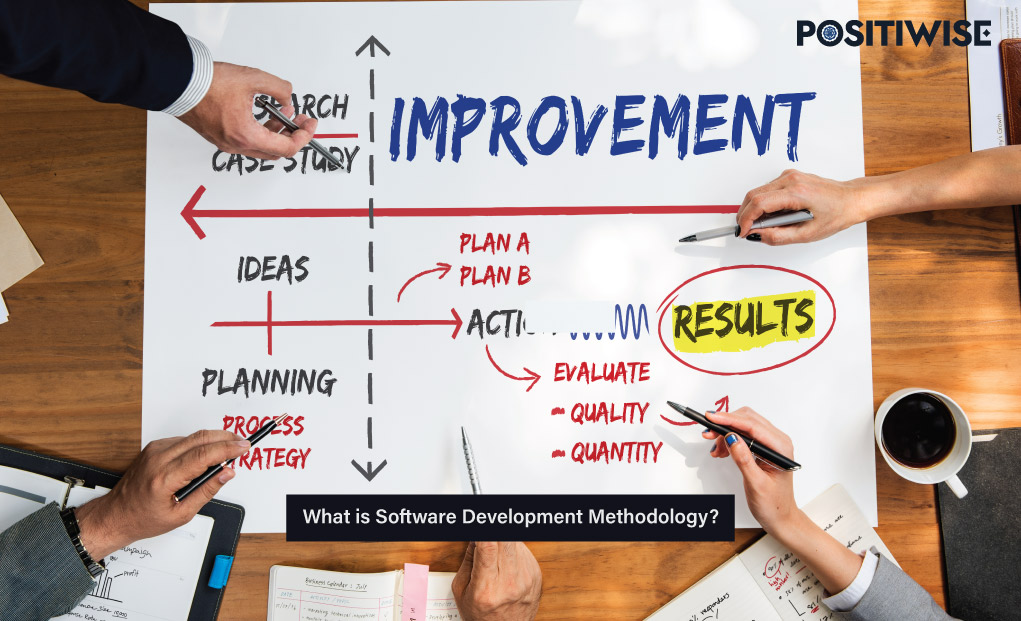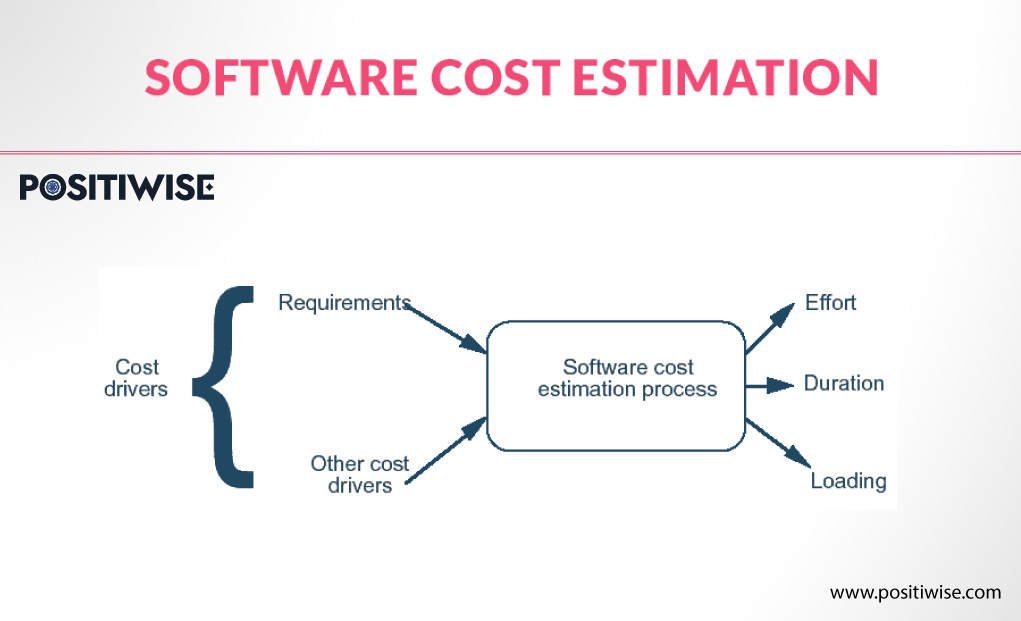Quick Overview:
Every day, teams plan, design, develop, and roll out several software applications, requiring immense focus and collaboration.
For this purpose, software companies consider modern software development methodologies to evaluate client requirements and fabricate a robust business solution within schedule.
Whether you are a client of some Software development company who wants to get a customized solution for your business needs or working as an internal team member in the development project who is responsible for delivering high-quality software products, it is necessary to know the software development models and methodologies that guide the entire software development process from planning to deployment and maintenance.
So, let’s get ahead together and understand the concepts, involved steps, pros, and cons, and get all the information about different software development methods.
A Rundown of the Software Development Methods
Before reaching the types of software development methodologies, it is vital to learn about a development method.
The development team follows a straightforward process that consists of steps, phases, and guidelines to deliver the software. They follow this process until they deliver your software.
The best methodology for software development or projects is essential, as it guides the team to cover edge-to-edge clients’ business requirements and promises a feature-packed application. In addition, it also aids both parties to communicate and complete the software creation economically and in a timely manner.
Every IT firm does not follow a single structure or process. Every development methodology involves several steps. The dedicated software development team follows these steps until they deliver the software.
Collecting requirements from the stakeholders, developing a plan, crafting designs, innovating and testing the product, and finally delivering it to the client. These are some of the major components of the fundamental pillars of every software creation approach.
With so many authentic procedures available today, it can be confusing to pick out a relevant one for your project. But, to make your decision quick and definitive, you must ask yourself the below-listed questions:
- What type of project are you developing? Whether it is a web app, single page application, desktop software, or mobile app.
- What features do you want to integrate into the business solution?
- Which technology are you going to utilize?
- What is your team size, budget, and timeline?
- Evaluate whether the client needs a prototype or just the final product.
- Analyze the complexity and risks involved in the project.
You can add as many aspects for assessing and selecting the custom software development company to approach for your project. Further, we have outlined the most considered methodologies for software creation, which you can quickly adapt to maximize efficiency.
12 Different Software Development Methodologies
- Waterfall Model Methodology
- Agile Software Development Methodology
- Prototype Development Methodology
- Lean Development Methodology
- Scrum Methodology
- DevOps Methodology
- Feature Driven Development
- Rapid Application Development (RAD)
- Spiral Model
- Dynamic Systems Development Model Methodology
- Extreme Programming Methodology
- Joint Application Development Methodology
Knowing the most considerable and preferred development methodologies is a must for every team member in the development team. So, let’s get through the software development methodologies comparison and optimize the procedure of your software creation.
In 2021, 35.9% of companies utilized the DevOps Development Methodology, as per the evaluated statistics. The rest of the 64.1% of firms prefer Agile, Kanban, Waterfall, Scrum, and Lean methodologies.
According to Statista.com, 47% of the companies present globally prefer DevOps development methodology. In addition, on average, 30.8% of the organizations consider Agile, Scrum, Kanban, Waterfall, and Lean development methodologies.
Also, Agile development practices includes all its types, including Feature Development and Extreme Programming software development methodologies.
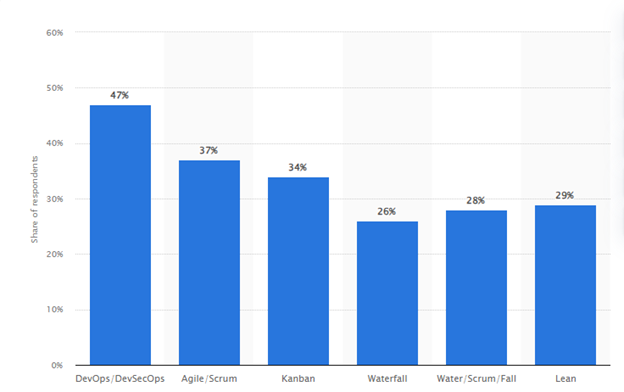
1. Waterfall Model Methodology
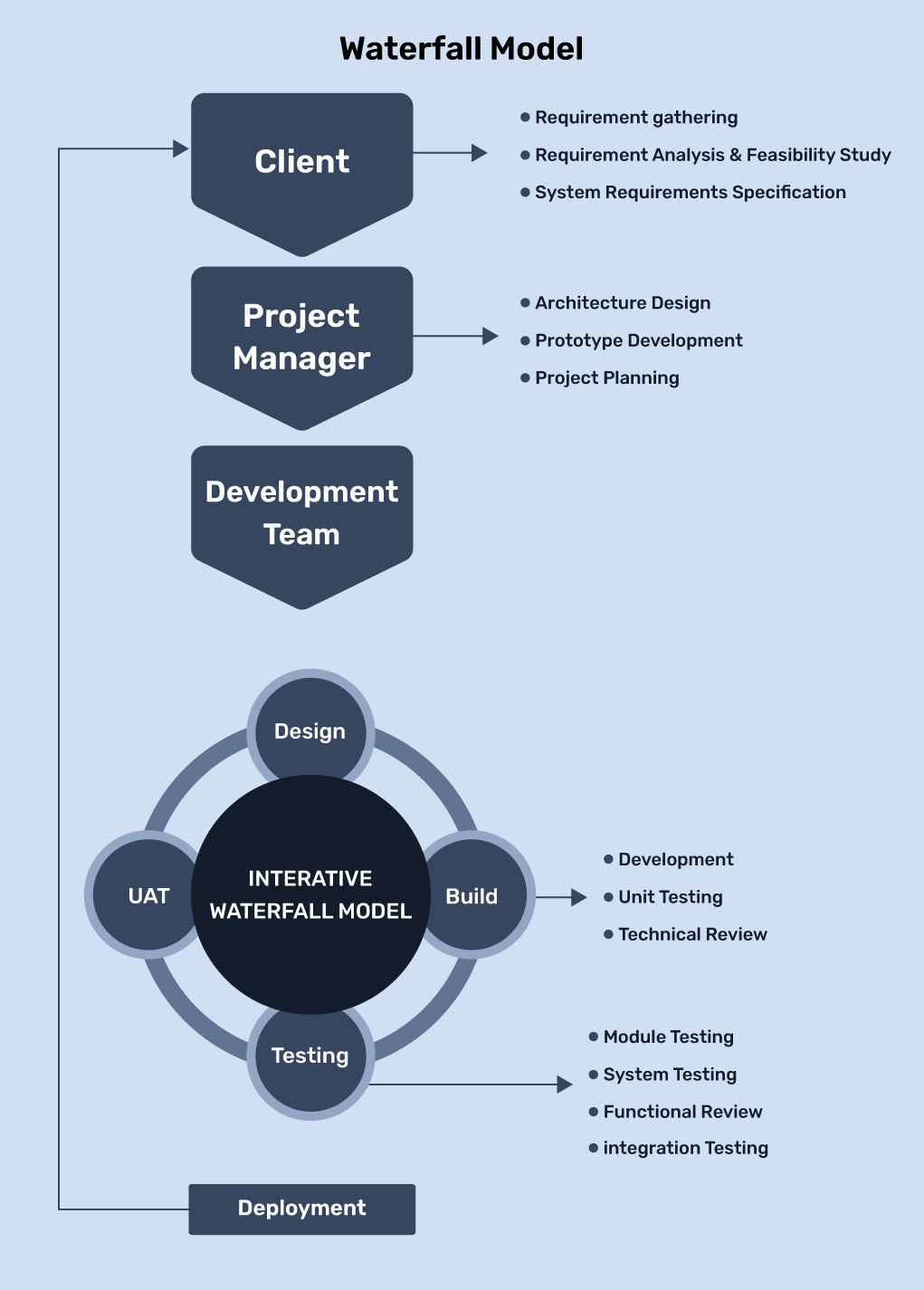
If you are working in software development, you must have heard about the Waterfall approach.
It is the traditional and essential procedure for furnishing a business application. Its linear structure divides the overall process into different phases, performed one after another. The next phase utilizes the output of the first phase as its input.
In the first phase, we utilize the gathered and analyzed information to design the software, and we take the designs as input for writing code. We continue this procedure until we reach the last phase.
If your project is simple, such as a static website, and you want to develop it at a minimum cost, this can be the appropriate approach.
Pros and Cons of Waterfall Model Methodology
| Pros of Waterfall Model Methodology | Cons of Waterfall Model Methodology |
|---|---|
| Clear and easy to follow the structure | Projects with dynamic changes cannot be handled |
| Tasks can be effortlessly assigned to each team memberFinal product goals are accurately set | Not possible to measure output before the final production |
| Tasks can be effortlessly assigned to each team member, and product goals are accurately set | The development team is not capable of identifying all the risks |
| The schedule is fixed, leading to having a higher chance of completing it before the deadline | – |
2. Agile Software Development Methodology
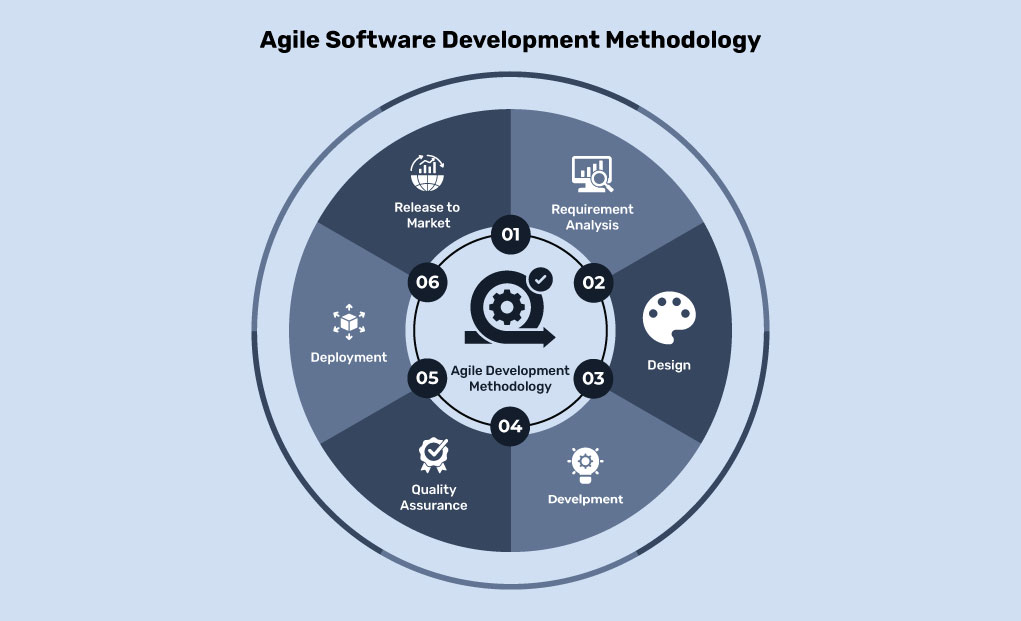
Small tech startups to large MNCs utilize Agile as one of the most popular software methodologies. This approach involves executing multiple small-term cycles, known as iterations, to incorporate all the modifications and changes defined by the client.
By analyzing the below-provided illustration of Agile software development methodology, you can better understand its procedure. We continuously perform the design, development, and testing phases whenever we receive a new business demand from the client.
The development procedure becomes flexible with iterations, ensuring the client receives feature-rich quality software.
The primary purpose of iterations is to add new functionalities, integrate APIs, configure protocols, and align the solution with industry standards. Moreover, it aids the development team in removing backlogs and providing a better version after each iteration.
If your ally ever has unclear software needs and you are crafting the project using different technologies, you must utilize this software development method.
Full-cycle Software Development Services
We at Positiwise understand your business needs and objectives to design custom software web applications to meet your online business needs. With our full-cycle software development services and a team of 50+ software developers with knowledge of different IT technologies and frameworks like .NET, PHP, WordPress, Woocommerce, and Python, we build custom software and web applications for different niches globally.
Pros and Cons of Agile Software Development Methodology
| Pros of Agile Software Development Methodology | Cons of Agile Software Development Methodology |
|---|---|
| Errors and Bugs are reduced in the final version | Project Management professionals are required to guide Agile project |
| Developers can embed cutting-edge features in software | Constant communication between the development team and the client is mandatory |
| The budget is planned before initiating any iteration | Time-to-market can be increased due to excessive modifications |
| Only the essential modifications are performed, as analysis is performed before implanting it. | – |
| Large and complex projects can be flawlessly handled | – |
3. Prototype Development Methodology
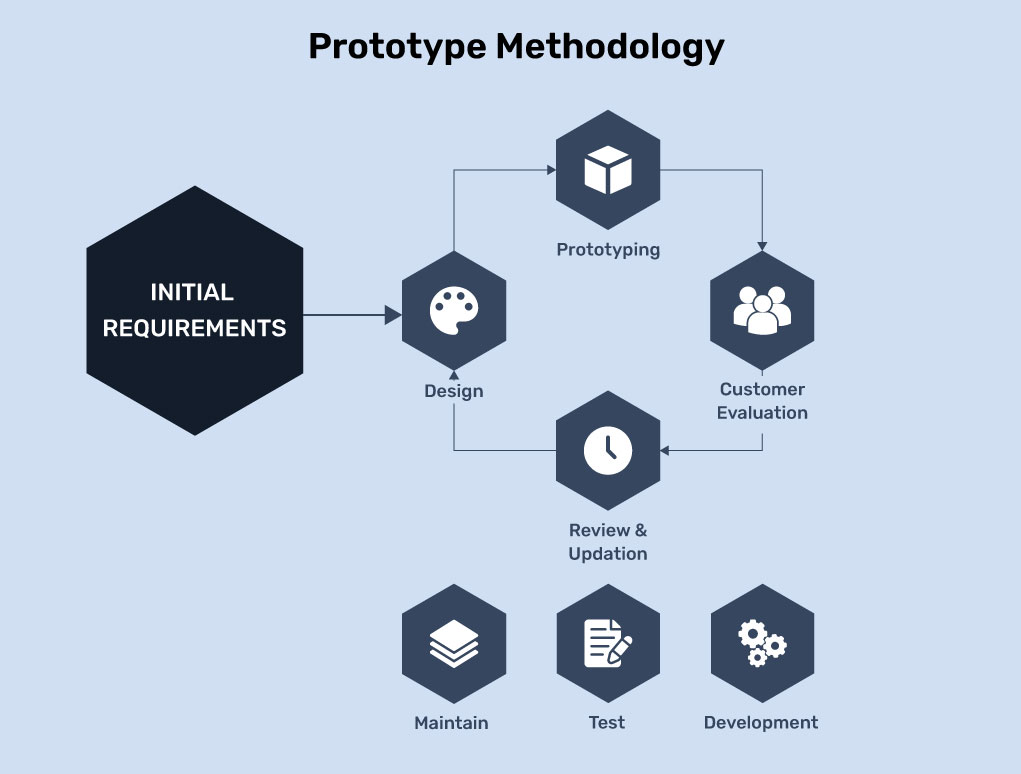
When it comes to saving cost, rather than performing multiple development iterations, the Prototype method tops the list of any project manager.
You must have heard about prototypes and maybe even generated or reviewed one at some point.
The prototype can be a blueprint, image, or video, representing the look and defining the basic functionalities of the final software. The main objective of selecting this mechanism is to clarify the client requisites to the development team and reduce risks during the development phase.
Pros and Cons of Prototype Development Methodology
| Pros of Prototype Development Methodology | Cons of Prototype Development Methodology |
|---|---|
| Risks are identified and resolved in the initial stage | More changes can expand the schedule |
| The development procedure is streamlined | The total cost can be evaluated only after finalizing the prototype |
| The team is clear about all the technologies to be integrated into the solution | Not suitable for a project with several changing requirements |
| Client and team have ample time to discuss and finalize changes | – |
4. Lean Development Methodology

As the name suggests, the Lean development approach consists of minimum phases to optimize productivity and reduce cost.
Stakeholders collect feedback and perform only relevant modifications to patch loopholes and handle exceptions.
Furthermore, the project team focuses on identifying maximum risks before Development to ensure a smooth workflow.
Pros and Cons of Lean Development Methodology
| Pros of Lean Development Methodology | Cons of Lean Development Methodology |
|---|---|
| There are no repetitive tasks, which cuts the cost and makes the project economical. | Finding skilled human resources for fast Development is not easy |
| Software is rolled out in minimum time | Developing software without proper design can create bottlenecks |
| A fixed cost can be calculated for the entire procedure | – |
5. Scrum Methodology
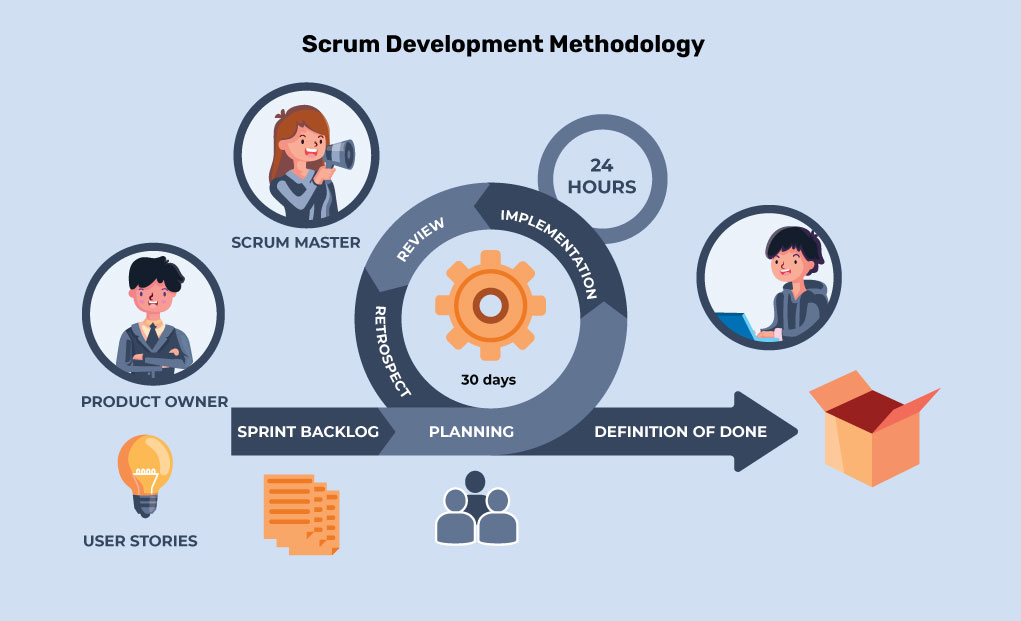
Scrum is an Agile development methodology, but the only difference is that it uses sprints instead of iterations.
In simple terms, a sprint is a fixed amount of time in which a development team has to complete their work—the primary goal of executing sprints is to remove backlogs from the project.
Planning, Standup meetings, Demos, and Retrospectives are the primary components of a sprint. First, the client arranges a meeting to plan and assign work to team members for the next 2 to 4 weeks.
Furthermore, the team conducts daily meetings where each member shares their progress. After completing all the defined tasks, the manager checks the product and sends a report to the customer for feedback. Finally, the team convenes a weekly meeting to discuss the barriers they encountered during the sprint and determine strategies for their elimination.
After completing the planned tasks and assessing retrospectives, we start the sprint and continue this process until we deliver the software.
Pros and Cons of Scrum Methodology
| Pros of Scrum Methodology | Cons of Scrum Methodology |
|---|---|
| Better Collaboration between client and team | An expert team is required due to the fast pace work culture |
| Quality products are furnished | Not suitable for large-scale projectWavering cost |
| Bugs, errors, and glitches are easily removed due to regular sprints | – |
| Enhanced flexibilityTeam Management is easy | – |
| Changes are integrated impeccably | – |
6. DevOps Methodology

The adoption of DevOps methodology is rapidly growing among all the software development methodologies due to its efficient collaboration structure leading to shortening the software development time.
Deploying and maintaining software is the responsibility of the IT team, which works independently from the development team. However, by following this approach, you can enable both these teams to join forces and foster the innovation of robust software.
As a result, you can ensure a single ultimate team with no communication barriers, providing a well-architect ground to build, test, and roll out the application.
Pros and Cons of DevOps Methodology
| Pros of DevOps Methodology | Cons of DevOps Methodology |
|---|---|
| Rapid product delivery to the client | Traditional working culture needs to be changed |
| Modifications are deployed effortlessly | Extensive testing and interaction between teammates |
| Simultaneously working of both teams guarantees better results. Disruption is minimized | The requirement of advanced tools can increase the project budget |
7. Feature Driven Development

Feature Driven Development, or FDD, is an advanced development methodology based on Agile principles and iteration mechanisms. Primarily, FDD focuses on designing and developing features in an incremental and iterative manner. And the primary purpose of preferring it includes:
- Elimination/minimization of rework
- Removal of confusion among team members or team and the client
The software development methodologies list is quite long. But, when it comes to selecting an approach for long-term and large projects, the FDD methodology is highly preferred. In addition, it includes five main stages or steps as follows:
- Stage 1: Develop an overall model
- Stage 2: Build a feature list
- Stage 3: Plan by feature
- Stage 4: Design by feature
- Stage 5: Build by feature
All the stages are executed incrementally, one after the other. Firstly, all the requirements are gathered to build an initial object model with the help of domain experts and developers. Further, all the required features are listed and divided into sub-tasks or sub-domains. Following it, the team plans which features are urgent, what needs to be secured more, which features involve more risk, and similar. Lastly, the sub-teams start to design and develop features per the plan in a two-week iteration, which gets incremented accordingly.
Pros and Cons of Feature-Driven Development (FDD)
| Pros of Feature Driven Development (FDD) | Cons of Feature Driven Development (FDD) |
|---|---|
| Clear Structure: FDD provides a structured approach with well-defined phases, making it easier for teams to follow a systematic development process. | Complex for Small Projects: FDD’s structured nature might be excessive for small projects with limited requirements, potentially leading to over-engineering. |
| Focus on Features: FDD emphasizes building software around concrete features, ensuring that user needs are addressed effectively. | Initial Overhead: FDD requires upfront planning and design, which can lead to higher initial overhead compared to more agile methodologies. |
| Team Collaboration: FDD promotes collaboration by breaking development into cross-functional teams responsible for specific features. | Documentation Burden: The comprehensive documentation required in FDD can become burdensome, especially in rapidly changing environments. |
| Predictable Progress: Due to its phased approach, FDD often offers more predictable progress tracking and milestone achievements. | Rigidity in Change: FDD’s structured nature can make it challenging to accommodate significant changes or shifts in requirements mid-project. |
| Quality Emphasis: FDD includes rigorous inspections and reviews, leading to higher code quality and reduced chances of defects slipping through. | Dependency Management: Managing dependencies between features can become complex, potentially leading to delays if dependencies are not well managed. |
8. Rapid Application Development (RAD)
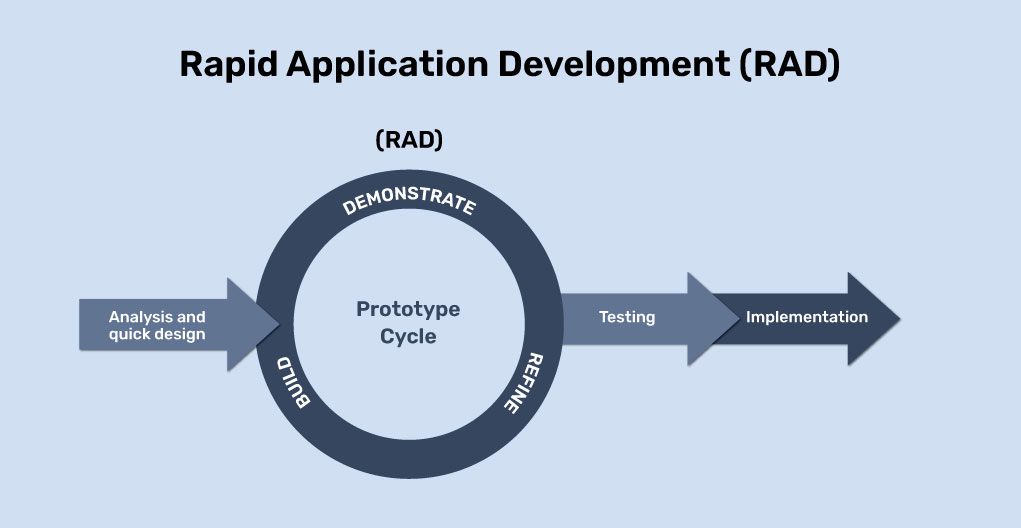
RAD is considered the fastest among all the software development practices and methodologies. Its main focus is developing the software solution rather than collecting requirements and defining goals and objectives.
In addition, prototypes play a crucial role in custom web application development. Developers build multiple application prototypes directly after having a clear insight into the client’s requirements. Each prototype illustrates the basic functioning and interface of the final application. Also, after receiving the feedback, the prototype gets refined and showcased again.
The prototype development cycle is continuous until the client doesn’t finalize the changes. Once it happens, the developers build a business solution per the prototype design, test it, and deploy it for end users. Furthermore, the complete RAD process moves so fast that the experts rapidly curate and deliver the software with the utmost quality, all the features, and stable functionality.
Pros and Cons of Rapid Application Development (RDD)
| Pros of Rapid Application Development (RAD) | Cons of Rapid Application Development (RAD) |
|---|---|
| Quick Development: RAD emphasizes rapid prototyping and iterative development, leading to faster delivery of working software. | Limited Scalability: RAD might not be suitable for large-scale and complex projects that require extensive architecture and planning. |
| User Involvement: RAD involves frequent user feedback and collaboration, ensuring the software aligns with user needs and expectations. | Dependency on User Availability: Frequent user involvement can be a challenge if users are not readily available for feedback and validation. |
| Adaptive Changes: RAD allows for easy incorporation of changes and modifications, accommodating evolving requirements throughout the development process. | Risk of Incomplete Requirements: Rapid iterations might lead to incomplete requirement analysis, potentially resulting in missing functionalities. |
| Reduced Documentation Overhead: RAD focuses on working prototypes, reducing the need for extensive upfront documentation, which can save time. | Quality Concerns: The rapid pace might lead to overlooking certain quality aspects, such as thorough testing and code optimization. |
| Early Functionality: RAD produces functional prototypes early in the process, which can be beneficial for user validation and early testing. | Complex Management: Managing frequent iterations and changes can become complex, requiring effective project management and communication. |
9. Spiral Model
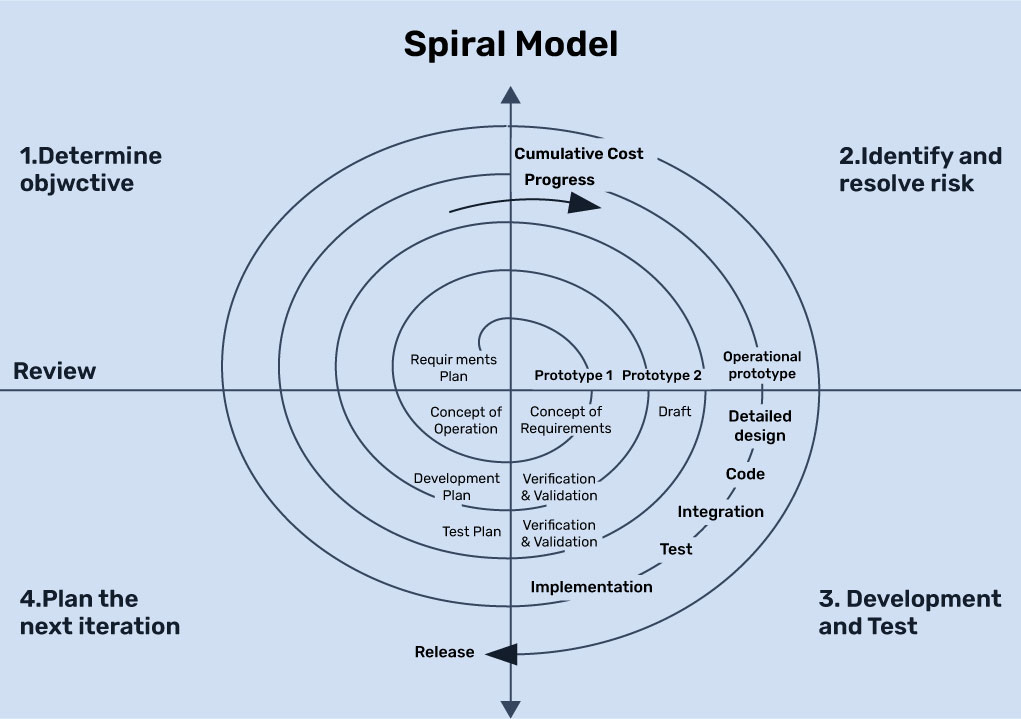
The spiral model is essential among software engineering methodologies, as it helps identify risks in the early stages. Also, the project management professionals consider it for efficient risk handling throughout the software development.
While seeing the diagram of a spiral model, you can get confused between its phases. But, in the real world, it’s quite seamless to implement it and align the project accordingly. When developers start with spiral methodology, they initiate by discovering the risks and then moving towards the development by managing them.
For instance, suppose you are developing an input form and identified that an SQL injection can be performed on it. But, to mitigate it, you suggested that the team implement input sanitization during development. The SQL injection is the risk you identified before development in the spiral model.
Similarly, the development team discovers risks and handles them in a spiral iteration.
Further, the process of the spiral is easy to understand. It consists of four major phases: planning, risk analysis, engineering, and evaluation. Firstly, the development team defines goals and then discovers risks and mitigation mechanisms. Following it, software gets developed, and the plan for the next iteration is determined based on the output.
Pros and Cons of Spiral Model
| Pros of Spiral Model | Cons of Spiral Model |
|---|---|
| Risk Management: The Spiral Model emphasizes risk assessment and mitigation at each phase, leading to better risk management. | Complexity: The model’s iterative nature can introduce complexity in project management, especially for small projects. |
| Flexibility: The iterative approach of the Spiral Model allows for flexibility in accommodating changes and evolving requirements. | Resource Intensive: The repeated cycles of planning, designing, building, and testing can be resource-intensive and time-consuming. |
| User Involvement: Frequent prototypes and iterations involve users early, resulting in better alignment with user needs and expectations. | Lack of Structure: The model’s flexibility can lead to a lack of clear structure if not managed properly. |
| Continuous Improvement: The model promotes continuous improvement through iterative refinement of the software product. | Requires Experienced Team: Effective risk assessment and decision-making demand an experienced team, making it less suitable for novice teams. |
| Progressive Development: The Spiral Model allows for gradual development and enhancement of the product, which can be particularly useful for complex projects. | Costly: The risk assessment and iteration phases can lead to increased project costs due to extended development cycles. |
10. Dynamic Systems Development Model Methodology
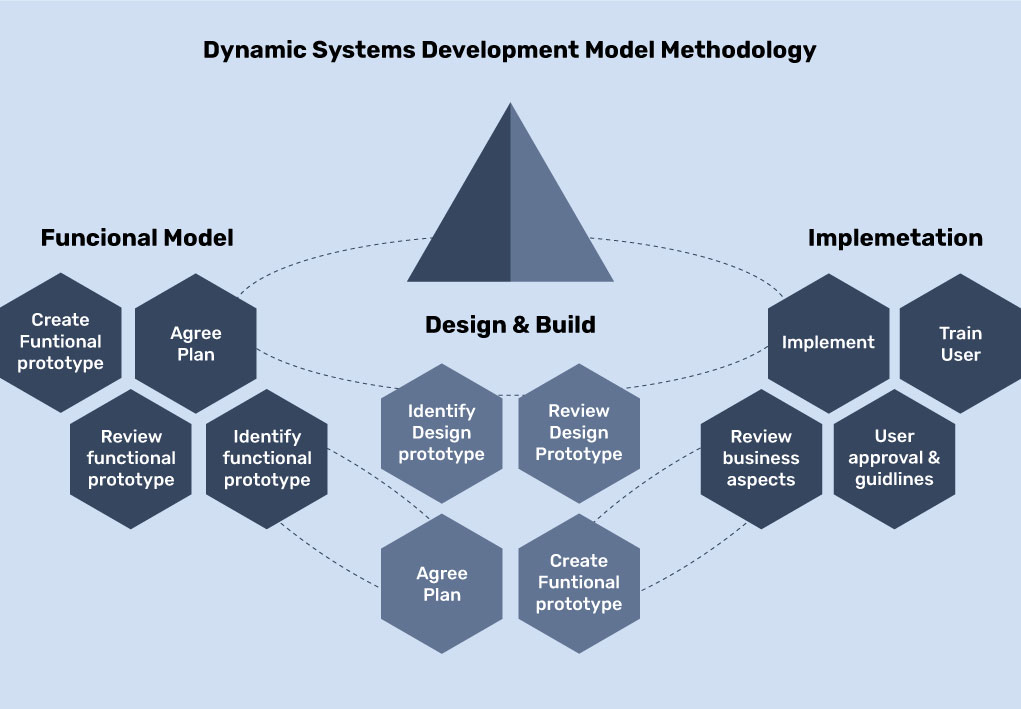
The DSDM or dynamic system development model is among the fastest software development methodologies. When you utilize DSDM for your project, you can ensure that the development company will deliver your software on time and within the defined budget only.
Most of the principles of DSDM are based on RAD or Rapid Application Development, which makes it faster than other development and design methodologies in software engineering best practices. Also, it requires constant user involvement from the initial stage to eliminate additional time, cost, and effort for unwanted features and functionalities.
In addition, only highly experienced professionals can work with the DSDM model, as the time and cost are limited compared to the client’s requirements. Instant decision-making, designing, development, testing, and deployment are the main priorities of this software development methodology. Also, per its philosophy, delivering solutions on time is more important than any other thing.
Pros and Cons of Dynamic Systems Development Model Methodology
| Pros of Dynamic Systems Development Model (DSDM) | Cons of Dynamic Systems Development Model (DSDM) |
|---|---|
| User-Centric Approach: DSDM strongly emphasizes involving users throughout the development process, ensuring that the final product meets user needs. | Learning Curve: DSDM may have a learning curve for teams new to its principles and practices, potentially impacting initial project efficiency. |
| Flexibility: DSDM’s iterative and incremental approach allows for adapting to changing requirements and priorities, leading to a more responsive development process. | Documentation Pressure: DSDM promotes minimal documentation but might not suit organizations or projects with strict documentation requirements. |
| Clear Roles and Responsibilities: The methodology defines specific roles and responsibilities, reducing ambiguity and improving collaboration within the team. | Resource Intensive: The emphasis on user involvement and collaboration requires active participation, which can be resource-intensive. |
| Early Delivery of Functionality: DSDM promotes delivering functional increments early, allowing for quicker user feedback and validation. | Not Suitable for All Projects: DSDM’s focus on user involvement and collaboration might not be suitable for all project types or organizations. |
| Business-Centric: DSDM aligns development with business goals and objectives, helping to ensure that the final product has tangible business value. | Risk of Scope Creep: The iterative nature of DSDM could potentially lead to scope creep if changes are not effectively managed. |
11. Extreme Programming Methodology
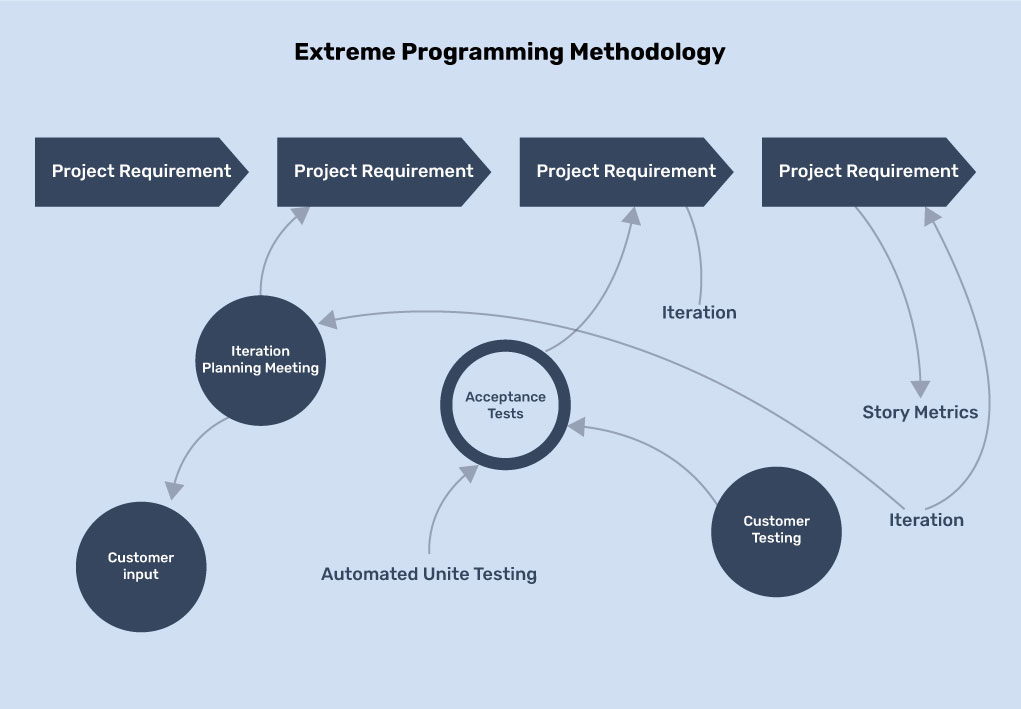
Extreme programming methodology (XP) is an agile software development methodology sub-type. Companies use it for producing high-quality solutions at low requirement cost. Primarily, it gets used if the following four situations occur:
- The client has dynamic requirements and needs to modify as the project moves.
- The development is small or medium in size.
- The tech stack leverages to benefit from functional and unit tests using automated mechanisms.
- There’s a probability of facing risks due to fixed time and usage of a new/advanced technology.
In addition, XP software development methodology’s main purpose is to let developers use all the good practices and unleash the maximum potential. For instance, if unit testing is good, all developers must perform it before pushing the code to the production repository or the next phase. As a result, the quality increases, and solutions cover the business requirements.
Pros and Cons of Extreme Programming Methodology
| Pros of Extreme Programming (XP) | Cons of Extreme Programming (XP) |
|---|---|
| Customer Satisfaction: XP emphasizes frequent customer involvement, leading to a higher likelihood of delivering software that meets customer needs. | Not Ideal for Large Teams: XP’s practices might become harder to manage and coordinate in large development teams. |
| Adaptability: XP’s iterative approach allows for easy adaptation to changing requirements and priorities throughout the project. | Learning Curve: Adopting XP may require a significant learning curve for teams new to its practices and principles. |
| Code Quality: Emphasis on code simplicity, continuous testing, and pair programming contributes to improved code quality and maintainability. | Documentation Concerns: XP’s minimal documentation approach might not align well with organizations or projects with strict documentation requirements. |
| Frequent Releases: XP promotes regular releases of working software, enabling users to see progress and provide feedback earlier in the development process. | Resource Intensive: Practices like pair programming can be resource-intensive, requiring careful management of team resources. |
| Team Collaboration: Pair programming, collective ownership, and constant communication foster strong collaboration among team members. | Not Suitable for All Projects: XP’s practices might not be suitable for projects that require extensive upfront planning or have rigid contractual agreements. |
12. Joint Application Development Methodology
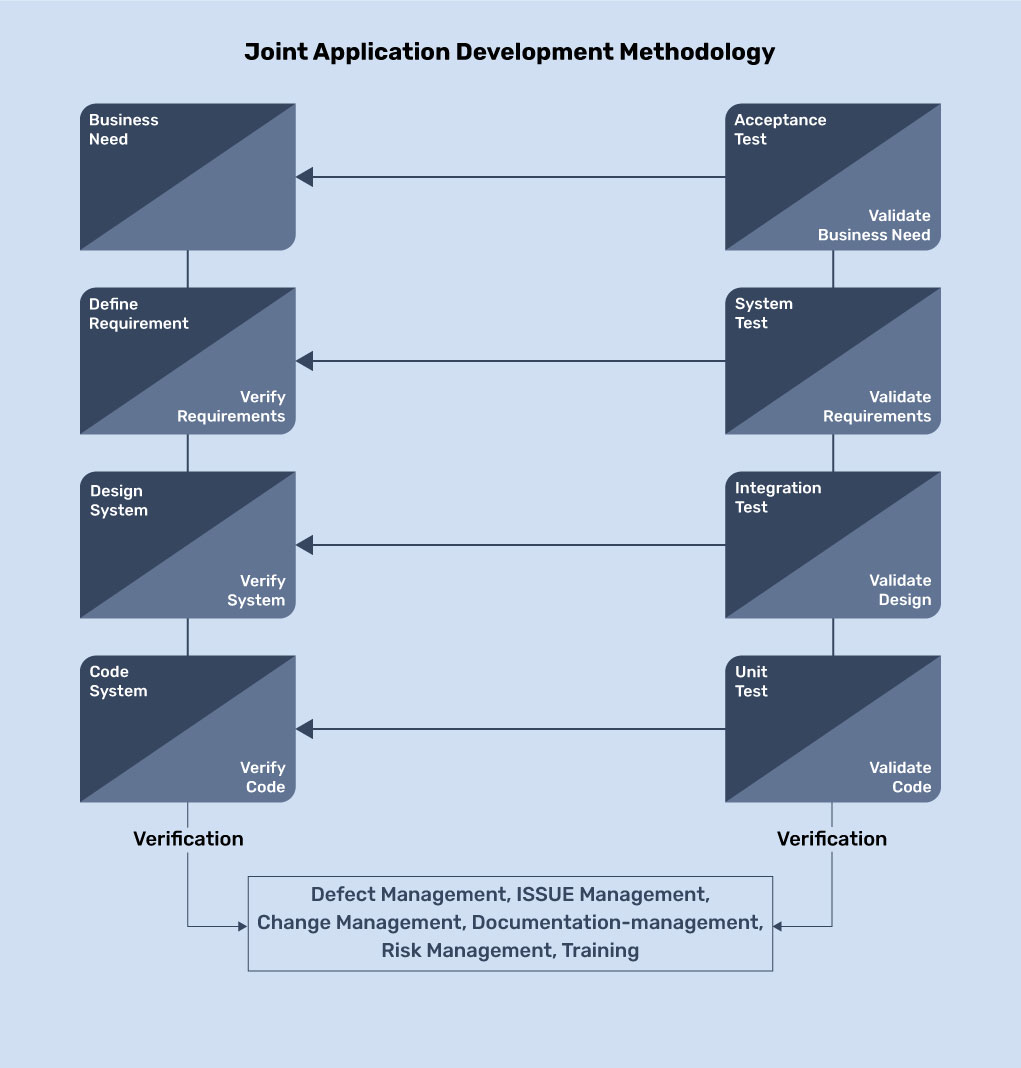
As the name defines, Joint Application Development or JAD requires all the stakeholders, such as end-users, to participate throughout the design and development phase. The JAD methodology includes an additional task, which is JAD meetings and workshops conducted at frequent intervals.
The primary aim of JAD workshops is to avail of feedback from the users and plan further development tasks accordingly. Also, the following are the top projects for which development professionals consider the JAD approach:
- Building software from scratch.
- Modernization of software used by an organization for inter-department communication.
- Applications with multiple users, such as vendors, end-users, customers, and more.
Moreover, the JAD model is highly suitable for enterprise system development, focusing on streamlining business complexities. It also helps save effort, time, and cost as developers establish direct communication with end-users. It helps them to effectively identify the exact requirements and make relevant changes in the final product.
Pros and Cons of Joint Application Development Methodology
| Pros of Joint Application Development (JAD) | Cons of Joint Application Development (JAD) |
|---|---|
| Enhanced User Involvement: JAD involves stakeholders directly in the requirements gathering and design phases, leading to a better understanding of user needs. | Time-Consuming: JAD sessions can be time-consuming, requiring the active participation of stakeholders, which might lead to longer project durations. |
| Reduced Miscommunication: JAD sessions promote direct communication between developers and stakeholders, reducing misunderstandings and ensuring accurate requirements. | Scheduling Challenges: Coordinating the schedules of multiple stakeholders for JAD sessions can be challenging, causing delays. |
| Quick Decision-Making: JAD allows for rapid decision-making as stakeholders are present to resolve issues and provide clarifications in real time. | Lack of Flexibility: JAD might be less adaptable to changing requirements than more agile methodologies. |
| Clear Requirements: JAD’s collaborative nature helps gather comprehensive and detailed requirements, reducing the risk of missing critical features. | Dependency on Participants: The success of JAD sessions heavily relies on the active participation and availability of knowledgeable stakeholders. |
| Reduced Rework: By involving stakeholders early, JAD helps identify potential issues before they become costly problems, leading to reduced rework. | Resource Intensive: JAD requires resources and coordination to conduct sessions, which might not be feasible for all projects or organizations. |
Accelerate Your Business with Custom Software Solutions
Struggling with outdated or ineffective software? Our expert team provides custom systems designed specifically for your business needs. We analyze your operations, build solutions to fit your workflow, and integrate with existing infrastructure.
Conclusion on Software Development Methodology
Software development methodologies are the fundamentals anyone associated with application development must know. These approaches help with software development, migration, modernization, and designing projects. As mentioned above, you can find numerous methodologies, such as Agile hardware development, Waterfall, DSDM, JAD, RAD, Scrum, Spiral, and more. But, you need to consider the project requirements, size, time, cost, risks, and several other factors before choosing the one.
However, you should consider consulting with a software development company, like Positiwise Software Pvt Ltd, to finalize the best software development methodology.
Expert in Software & Web App Engineering
Parag Mehta, the CEO and Founder of Positiwise Software Pvt Ltd has extensive knowledge of the development niche. He is implementing custom strategies to craft highly-appealing and robust applications for its clients and supporting employees to grow and ace the tasks. He is a consistent learner and always provides the best-in-quality solutions, accelerating productivity.
